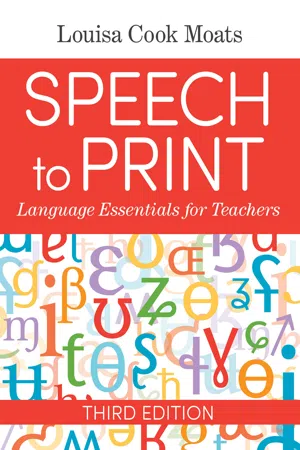
- 344 pages
- English
- ePUB (mobile friendly)
- Available on iOS & Android
About this book
Learn more about the new edition! For two decades, Speech to Print has been a bestselling, widely adopted textbook on explicit, high-quality literacy instruction. Now the anticipated third edition is here, fully updated with ten years of new research, a complete package of supporting materials, and expanded guidance on the how of assessment and instruction in today's classrooms. Filling a critical gap in teacher preparation courses, Speech to Print supplies K-12 educators with in-depth knowledge of the structure and function of language—fundamentals they need to deliver successful structured literacy instruction. Renowned literacy expert Louisa Cook Moats gives current and future teachers comprehensive, accurate, and accessible information on the underpinnings of language instruction, including:
- the history of the English language and its effect on spelling
- English phonology, including speech sounds and their distinctive features
- how print represents speech in English
- the morphological aspects of words
- syntax and its instruction
- how meaning is conveyed with language
Through case studies, activities, recommended teaching principles, and close analysis of real-world student work samples, teachers will also receive invaluable insight into how their students should be taught. Ideal for use in preservice courses and in-service professional development sessions, this essential textbook will give educators the strong foundation they need to teach language and reading skills to students with and without disabilities. WHAT'S NEW:
- New and expanded practical content on the how of language and reading instruction
- New and updated chapter exercises
- New faculty support materials
- More on key topics like program and curricula selection, frameworks for instructional planning, and problem solving when students are slow to respond to intervention
- More accessible, undergraduate-friendly tone and structure
- Additional graphics to illustrate key concepts
NEW FACULTY SUPPORT MATERIALS! Support your instruction with a complete package of online companion materials, including chapter quizzes, a sample syllabus/course outline, PowerPoints to accompany each chapter, PDF handouts for selected concepts, and a video demonstrating production of all the sounds in the English language. Watch the webinar recording
Frequently asked questions
- Essential is ideal for learners and professionals who enjoy exploring a wide range of subjects. Access the Essential Library with 800,000+ trusted titles and best-sellers across business, personal growth, and the humanities. Includes unlimited reading time and Standard Read Aloud voice.
- Complete: Perfect for advanced learners and researchers needing full, unrestricted access. Unlock 1.4M+ books across hundreds of subjects, including academic and specialized titles. The Complete Plan also includes advanced features like Premium Read Aloud and Research Assistant.
Please note we cannot support devices running on iOS 13 and Android 7 or earlier. Learn more about using the app.
Information

EXERCISE 1.1 | Implications of the Simple View of Reading |

Table of contents
- Cover
- Title Page
- Copyright
- Contents
- About the Online Companion Materials
- About the Author
- Foreword
- Acknowledgments
- Introduction: The Missing Foundation in Teacher Education
- Chapter 1: Why Study Language?
- Chapter 2: Phonetics: The Sounds in Speech
- Chapter 3: Phonology: Speech Sounds in Use
- Chapter 4: The Structure of English Orthography
- Chapter 5: Morphology for Reading, Spelling, and Vocabulary
- Chapter 6: Syntax: How Sentences Work
- Chapter 7: Semantics: Word and Sentence Meaning
- Chapter 8: Structured Language and Literacy Instruction
- References
- Appendix A: General Scope and Sequence for Reading and Spelling Instruction
- Appendix B: Glossary
- Index